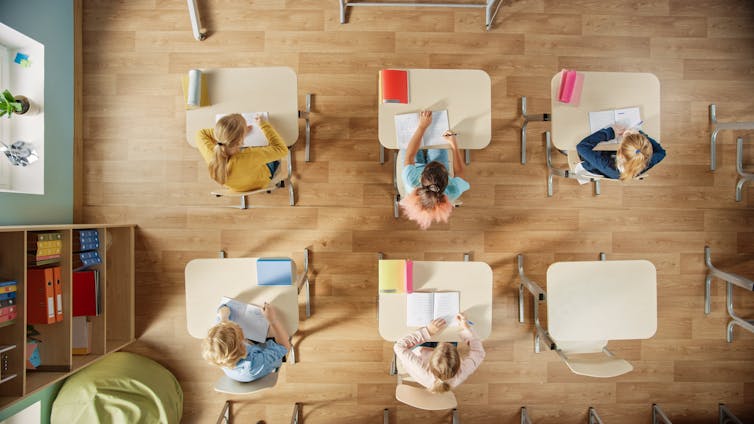When COVID shuttered schools around the world in 2020, the way teachers delivered their lessons and students did their classwork changed over night. As one Boston-based secondary school student wrote in a recent case study, “bedrooms turned into school classrooms, living rooms turned into science laboratories and backyards turned into workout gyms.”
Two years on, this shift to remote and, subsequently, hybrid learning has presented many challenges. It has caused stress and confusion for teaching staff and pupils alike. But it has brought surprising benefits too.
A recent report drawing together the results of 81 studies of secondary schools from 38 countries has highlighted how complementary these digital learning methods can be to traditional methods of schooling. Pupils have found working at their own pace, and without the social pressures of the classroom, beneficial. Even as we face the prospect of continued disruption in 2022, these are reasons to be hopeful.

Digital skills
During the pandemic, many schools had to make greater use of learning management systems and apps, in order to improve communication between school and home. It might seem obvious, but having to work remotely has encouraged teachers and students to revisit and enhance their digital skills. This has stimulated innovation and creative thinking, and prompted students to develop skills in using multiple digital tools and resources effectively for learning, such as those reported in a US study.
Many students have showed an increased ability to study and to problem-solve independently. Teachers in Hong Kong reported that students had developed problem-solving methods that their teachers hadn’t taught them.
Of the 2,824 secondary school pupils who responded to a survey in Slovakia, meanwhile, most said they’d found learning at their own pace to be invaluable. Having the ability to re-watch instructional videos helped them gain deeper understanding of their subjects and maintain a connection to their teachers.
In England, Sweden and the US, several students who, pre-pandemic, were reluctant to take part in lessons or go to class at all, reported becoming more involved and engaged with their schoolwork during lockdown, because they felt less social pressure. Instrumental music students in Australia also showed improvement in their social skills, including communication, negotiation and active listening.
Students in Austria, the US and Portugal also benefited from interacting with their peers - remote learning gave them new methods of collaboration, including developing interactive ePortfolios, using discussion boards to share ideas and conduct school work with peers, as well as collaborating on authentic tasks such as co-creating digital posters and videos, and distributing them via social media. One US study reported that using the chat function in Google Meet during live lessons, combined with editing work and writing comments in Google Docs, was particularly helpful for students to collaborate and stay in touch with their peers.

Communication and assessment
For some countries, shifting to online assessment, when they had formerly adopted a heavily standardised test-based culture, was quite difficult, as this now demanded alternative assessment methods that could also secure trustworthy results. While some countries forbade assessment during lockdown, our review uncovered the opposite too: no fewer than 21 online assessment strategies were identified. Thus, having to rely heavily on technology during lockdown did open new and creative modes of assessment design and delivery.
The two most common strategies used were formative assessment and online quizzes – identified in 16% of the studies we looked at. While formative assessment has previously been found to boost student learning, the two strategies were employed for different reasons.
Formative assessment, often conducted in real time, was supported by video-conferencing tools. It enabled teachers to see and hear their students, which supported the assessment of literature talk and language assessment, including role plays, online debates and drama performances. Teachers also reported that this real-time interaction supported a sense of social presence, which is important for student wellbeing.
Online quizzes, meanwhile, allowed students to check their understanding at their own pace, which helped, as reported in an Indonesian study of Year 10 students, to stave off bordeom. Being auto-corrected, quizzes also helped to decrease teachers’ work load. Lastly, this kind of digital assessment was also easily shared between teachers, which supported equality and re-usability.
Parent engagement
Some parents reported enhanced digital skills as a result of the pandemic. But the main takeaway has been parents’ increased impetus to engage more in their children’s learning.

Research in Nigeria found that giving parents greater access to what their children were learning helped to improve the students’ commitment to learning online. In Vietnam, having parents on board in this way was found to make the whole process more effective.
Being able to access meetings with teachers virtually has also reduced social barriers for some families. A survey conducted by ParentPing in December 2020, found that both parents and teachers wanted to keep parent evenings virtual, or at least be given the option to do so.
School, more broadly, can and should become more flexible. Ensuring that it does will encourage inclusion and accessibility. It will support lifelong learning.

